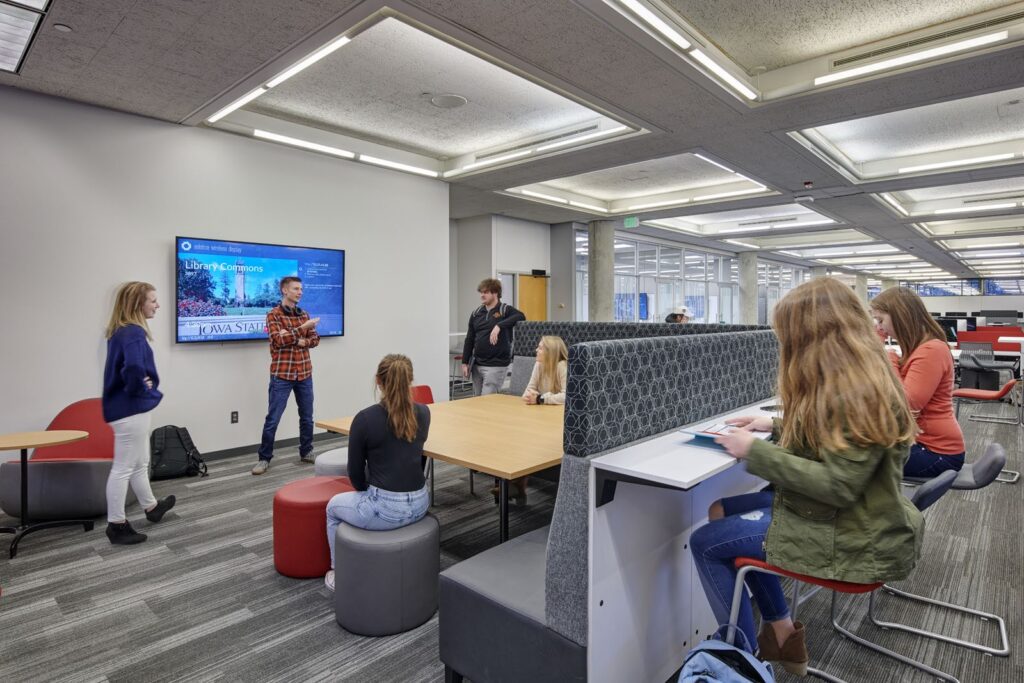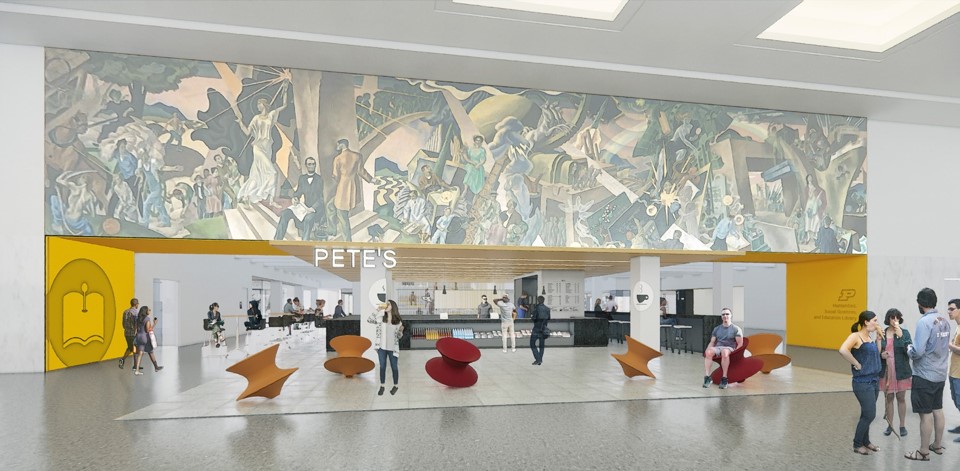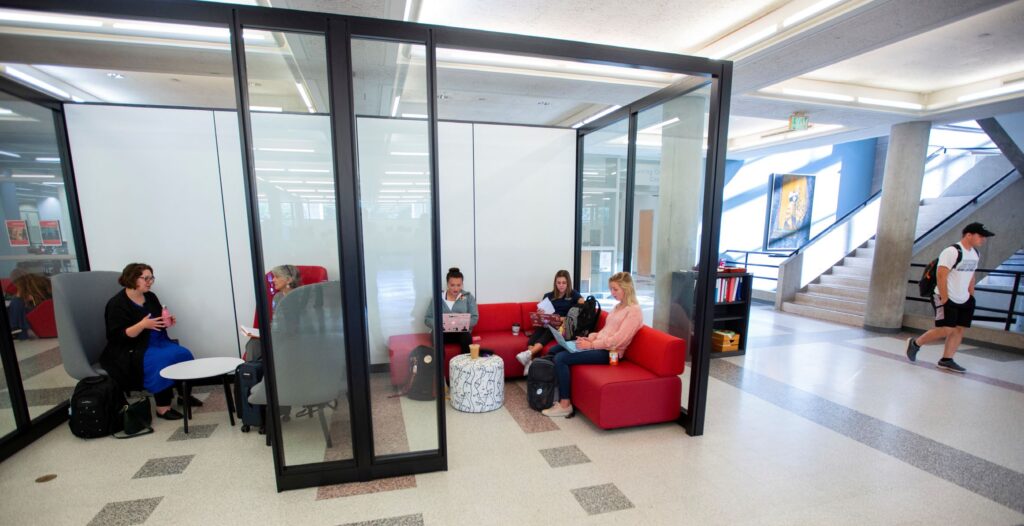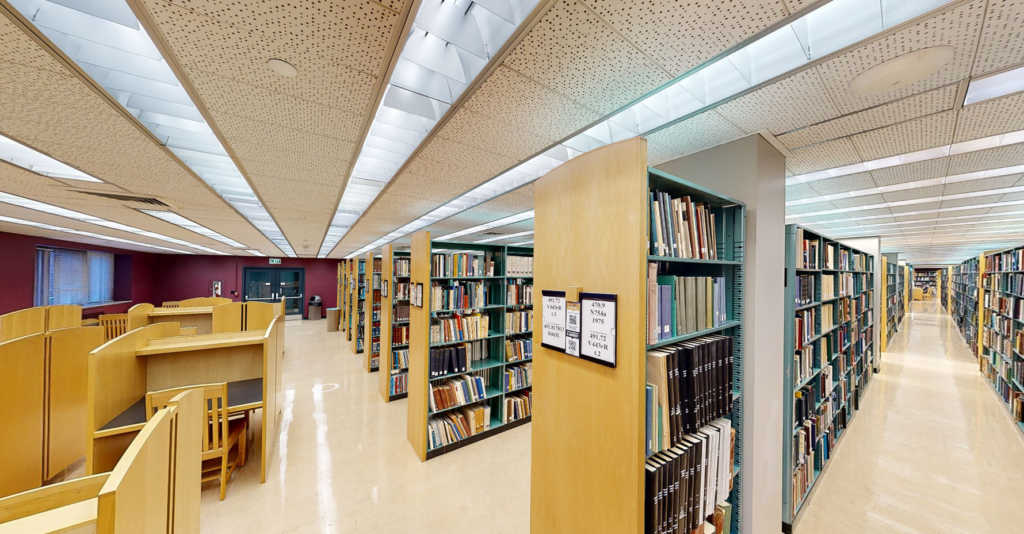The campus library is undergoing dramatic change. No longer just a quiet sanctuary devoted solely to books and hushed tones, today’s academic libraries now host dynamic, multifunctional hubs that foster learning, collaboration, and community building. Embedded smart technologies are helping designers measure and plan for these shifts that begin to lay the groundwork towards cultivating a sense of belonging.
As digital access has grown, the need for relentless aisles of browsable physical collections has diminished. Many libraries have moved books offsite, freeing up space for new human-centered functions. Instead of quantity, libraries now carefully curate thematic, interdisciplinary collections that reflect current events and student interests in more engaging ways.
Modern campus libraries now feature cafés. They host makerspaces. They tackle cutting edge technologies in soundproof study pods, media production studios and new digital literacies in generative AI Labs. And, yes, there are even spaces for food pantries, relaxation sleep pods, and haircuts. While quiet reading rooms remain, they’re now complemented by flexible, active environments that support diverse learning styles and encourage interaction for students and faculty alike.

Two Universities, One Smart Approach
With shifting expectations and rapid technological change, how can library administrators and their architects plan for the future and justify investments to university leadership? Two institutions — Iowa State University and Purdue University — found a path forward through innovative planning studies that leveraged smart technologies to understand real student behaviors and needs.
During the pandemic, students experienced a loss of in-person connection, emphasizing the value of high-touch, personalized learning environments. Libraries recognized they needed to evolve — not just to offer more inclusive and inviting spaces, but also to respond to the increasing demand for flexible, neurodivergent-friendly design.
At Purdue, surging enrollment created a space crunch across campus. The university needed to expand both academic and residential facilities, and libraries were asked to justify their footprint. Their solution: create spaces that not only accommodated more students but were also thoughtfully designed to support diverse learning needs to support student success.
At Iowa State, the return to campus after COVID ushered in increased online learning. Students now toggled between in-person and virtual classes, often using the library as a quiet place to attend online lectures. Engagement for online lectures was stymied when students sat in open areas. Administrators had to rethink the layout to include more private, sound attenuated booths or furniture with privacy features to ensure that students with sensory sensitivities had suitable spaces.
At both institutions, the perception that libraries held underutilized space created pressure from facilities departments eager to repurpose areas once used for book stacks. Library leaders needed compelling data to defend — and reimagine — their spaces.

Sensing the Future: Technology Meets Design
Traditionally, architects and planners relied heavily on surveys, interviews, and observational studies to understand library use. But these qualitative methods often left gaps in understanding. Occupancy sensors offer real-time, quantitative insights into how spaces are used throughout the day, week, and semester. These tools help answer questions like: Which rooms sit empty? Where do students cluster? How long do they stay?
“This technology gave us data we never had before,” said Hilary Seo, Dean of the Library at Iowa State University. “Gate counters told us how many people came in, but not where they went or how long they stayed. The sensors provided specific, actionable insights. Some confirmed our assumptions, but others surprised us.”
One such surprise? The “dwell time” — how long students remained in certain areas — was significantly longer than expected. Another insight challenged fears that a newly built Innovation Center would draw students away from the library. Archived sensor data showed the opposite: library traffic actually increased.

From Data to Design Decisions
Collecting data is only the beginning. The real value lies in analysis and context. For instance, two identical floors might show very different usage patterns. One could have more natural light, more outlets, or be closer to a staff service point. Understanding why students prefer one space over another is crucial — and often requires blending sensor data with anthropologic or observational research.
There’s also the subtle difference between perceived and actual occupancy. A table with four seats may register as half-empty if only two students are sitting there. In reality, that configuration may deter others from joining. This insight reshaped planning strategies.
“For decades in libraries it was about the number of seats you have, not whether or not anyone was in them. So it’s changed my thinking about how we do provide study space,” said Beth McNeil, Dean Emerita of Libraries at Purdue University.
Cross-referencing sensor data with other data sets — like classroom enrollment or departmental affiliations — reveals even richer patterns. At Purdue, they discovered that library usage correlated inversely with classroom occupancy in the same building. This suggested students were using the library between or even during classes, prompting new thinking about how to physically link learning spaces.


Technology as a Catalyst for Smarter Investment
In an era of tight budgets, capital improvements require strong justification. Sensor data has helped both Purdue and Iowa State make the case.
At Purdue, continued use of occupancy sensors has influenced decisions well beyond the library. When administrators sought funding to relocate books to offsite storage, library staff used data to argue for student-centered renovations. And after the renovation of the humanities library, the data showed student usage jumped by 172%, inspiring a donor to dedicate funding to renovate another library on campus.
At Iowa State, sensor data played a key role in a grant proposal to improve study spaces. Part of the proposal is to use continuously collected occupancy data for post-implementation assessment, reinforcing a culture of data-informed planning.
Looking Ahead
Combining sensor data with traditional qualitative methods gives campus libraries a powerful toolkit for shaping their future. It helps administrators align investments with real behaviors, not just anecdotal assumptions—and it demonstrates that libraries remain vital spaces for student success. From the Purdue and Iowa State experiences, it is clear that data is just the beginning. Data must first be calibrated to the specific mode of inquiry and cross-pollinated with other data sets. The data sets serve as prompts for the next set of questions. “What we learn from our students and partners is essential,” said Purdue University’s McNeil. “But knowing how many students are coming, how long they’re staying, and how they’re using the library lets us show we have a captive audience, and that audience wants more

